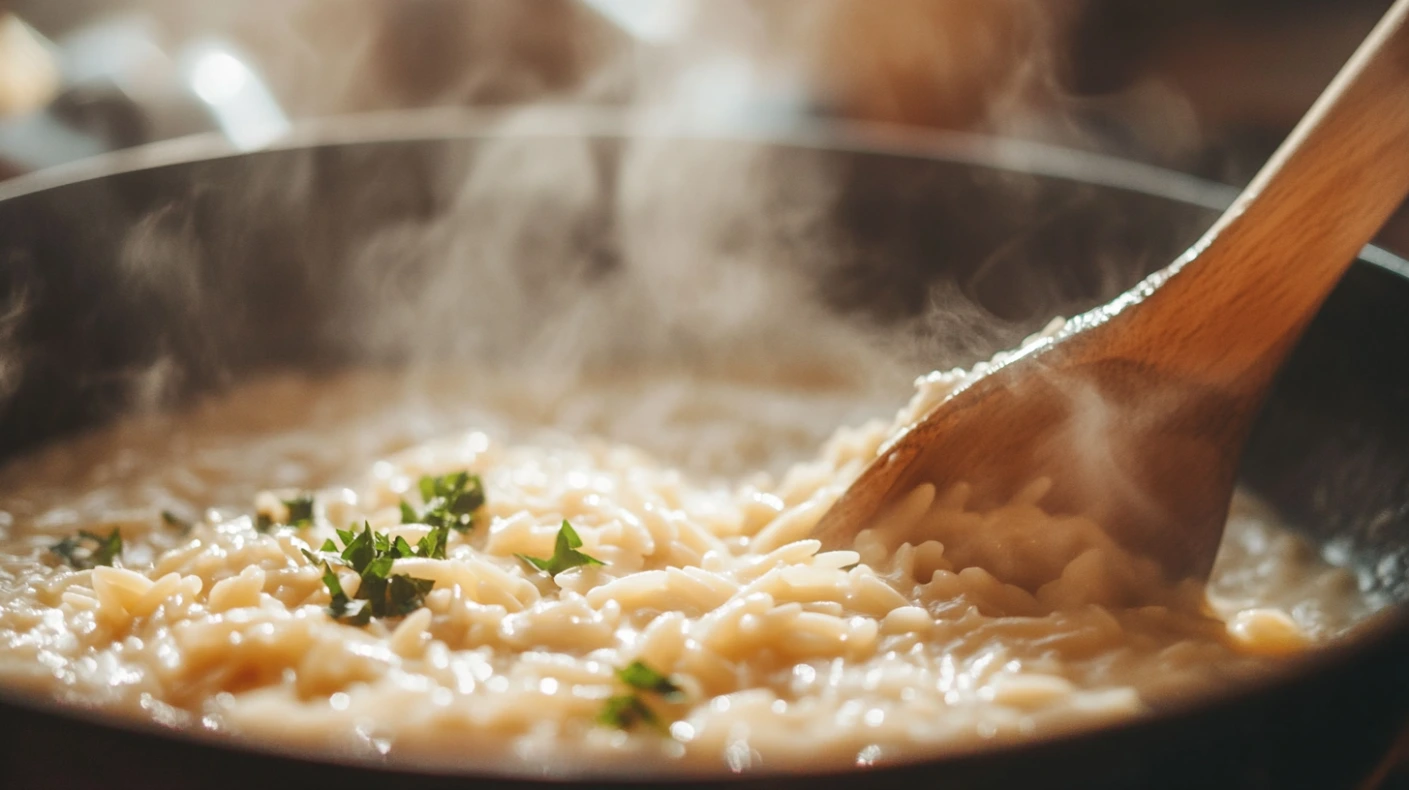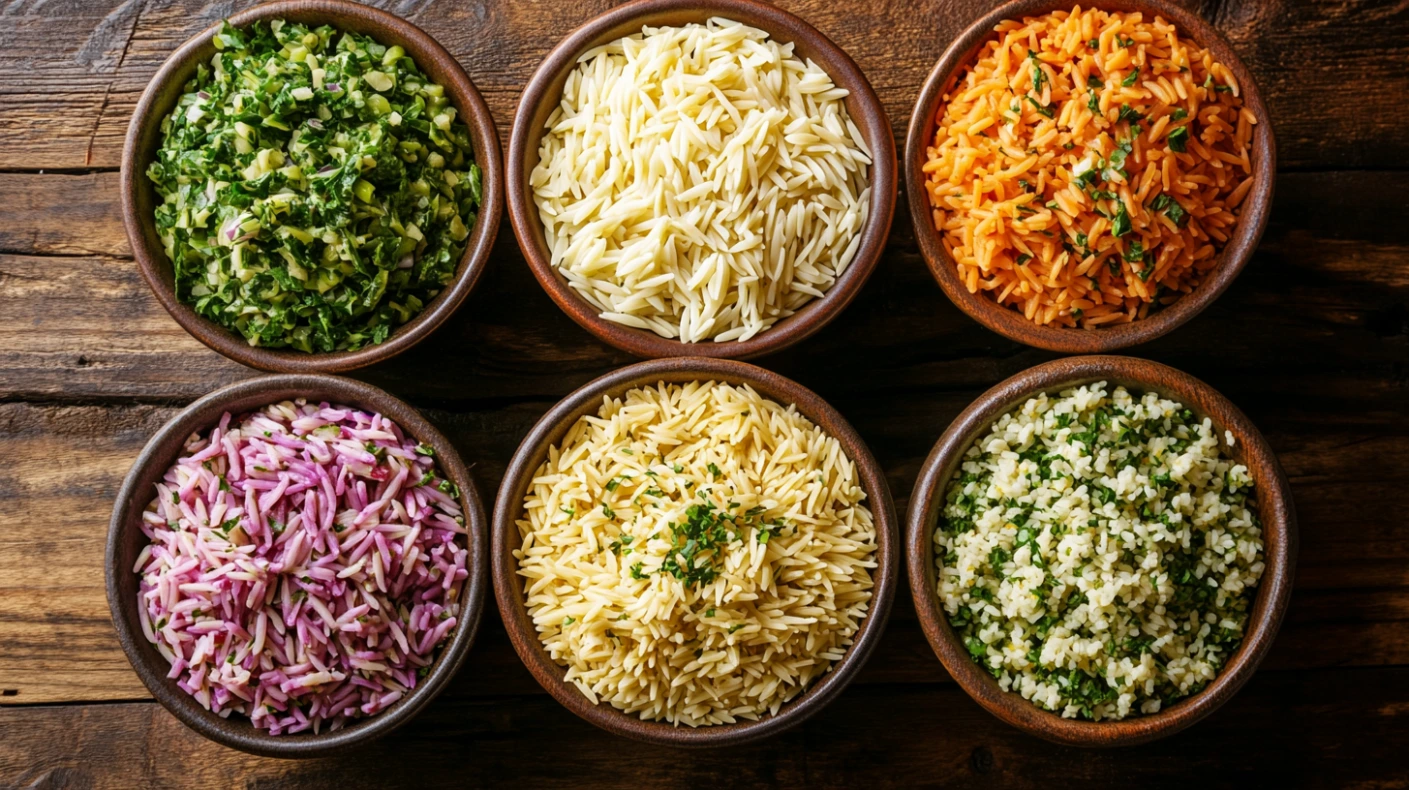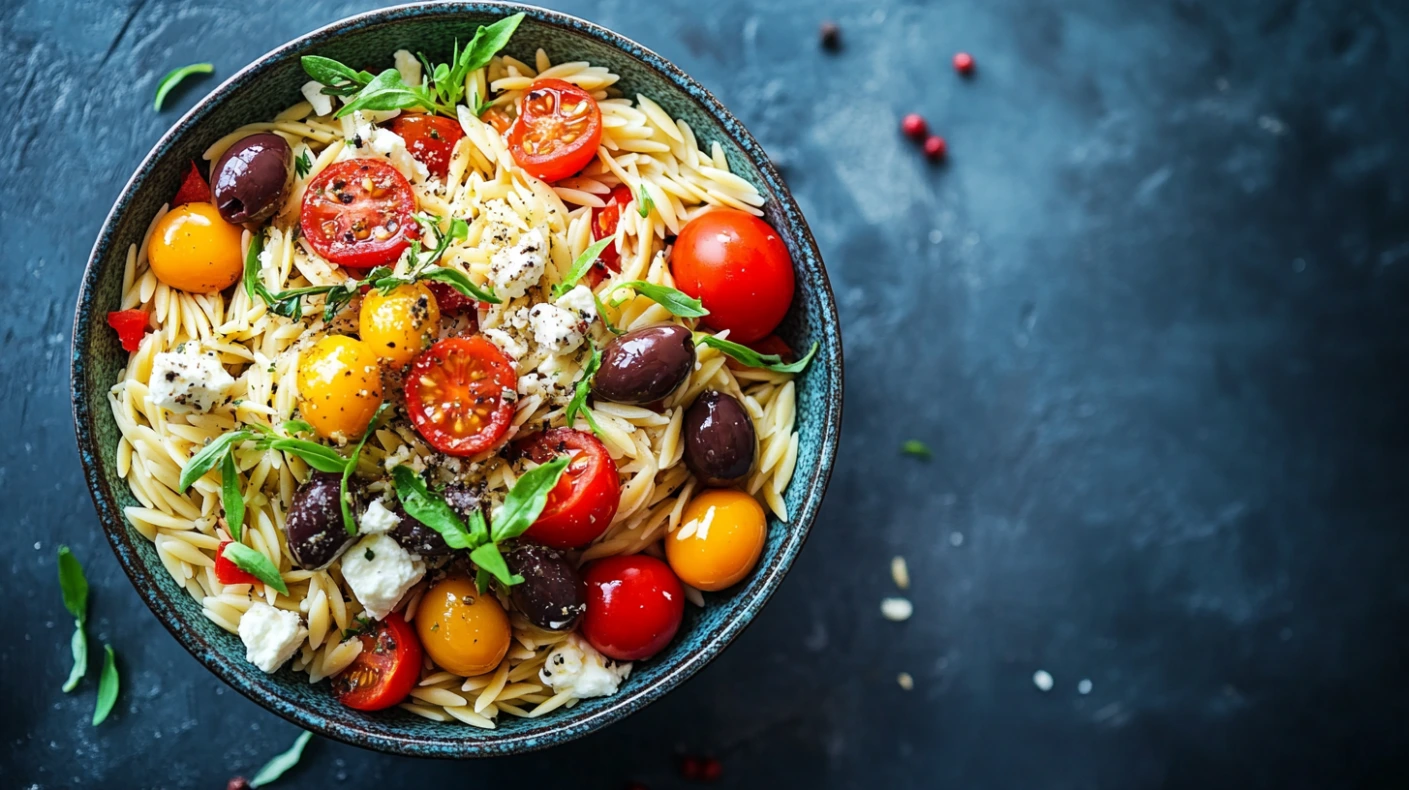Orzo, the tiny pasta with a rice-like appearance, is a versatile ingredient cherished by cooks worldwide. Its unique texture and ability to blend seamlessly into soups, salads, and one-pot meals make it a culinary favorite. This article delves into the origins, preparation methods, and creative uses of orzo, while exploring what sets it apart from similar ingredients like rice, risotto, and couscous. By the end, you’ll have a newfound appreciation for this delightful little pasta.
What Is Orzo?
Orzo, often mistaken for rice due to its small, grain-like shape, is actually a type of durum wheat pasta. Known as risoni in Italy, the word “orzo” translates to “barley,” reflecting its resemblance to barley grains. But what is special about orzo? is its remarkable versatility—it serves as a delightful substitute for grains in many recipes, while maintaining the heartiness of traditional pasta.
This rice-shaped pasta stands out for its quick cooking time and ability to absorb flavors, making it perfect for soups, casseroles, and salads. Its texture is both tender and slightly chewy, adding depth to every dish it’s part of. Whether you’re creating a hearty Italian soup or a refreshing Mediterranean salad, orzo effortlessly elevates the meal.
Orzo’s Popularity Across Cultures
One of the key reasons behind what is special about orzo? is its global appeal. While its roots are firmly planted in traditional Italian cuisine, orzo has gained popularity in kitchens worldwide. In Greece, it’s called krithiraki and is commonly paired with lemon, feta, and olives for a burst of Mediterranean flavors. Meanwhile, the Middle East features orzo in comforting dishes like shorbet lesan el asfour (orzo soup), highlighting its adaptability.
Orzo has become a bridge between cultures, celebrated for its ability to complement diverse ingredients and cuisines. Its versatility is matched only by its simplicity, making it a staple for both novice cooks and experienced chefs.
The Composition and Making of Orzo
Ingredients in Traditional Orzo
Orzo is typically made from durum wheat milled into semolina flour, known for its firm texture and nutty flavor. This flour gives orzo its delightful chewiness, making it perfect for dishes requiring texture and substance. Traditional recipes may add spring water to form the dough, keeping the ingredient list refreshingly simple. For those with dietary restrictions, gluten-free orzo is made using a blend of corn and rice flour.
Interestingly, some variations also include eggs for a richer flavor, though this is less common in commercial production. These simple ingredients not only highlight the elegance of orzo but also showcase its adaptability. By using high-quality flour, this rice-shaped pasta achieves a smooth, toothsome quality, distinguishing it from other pastas.
For more on how orzo’s composition compares to other pastas, check out Why Is Orzo Different From Pasta: A Complete Guide.
How Orzo Is Made
The art of making orzo has evolved over centuries, blending traditional methods with modern innovations. Historically, pasta artisans shaped orzo by hand, creating its signature rice-like form. Today, industrial machines handle production, maintaining consistency in shape and size.
The process starts with kneading semolina flour and water into a firm dough. This is extruded through specialized molds, forming tiny, oblong shapes. Once cut, the pasta is dried at low temperatures to preserve its distinct flavor and texture. This drying method mimics traditional Italian techniques, enhancing the pasta’s shelf life and quality.
Whether crafted by hand or machine, the making of orzo emphasizes its simplicity and culinary elegance. It’s no wonder that cooks worldwide consider it a pantry staple!
Cooking Techniques for Orzo
Boiling Method for Orzo
Boiling orzo is the easiest and most common way to cook it. Start by bringing 8 cups of water to a rolling boil. Add a pinch of salt and 1 cup of orzo, stirring occasionally to prevent sticking. In just 8 minutes, you’ll have tender pasta ready to transform any dish.
This method is ideal for soups like Italian Wedding Soup or for tossing orzo with butter, garlic, and Parmesan cheese. When cooked al dente, orzo’s texture absorbs sauces beautifully, making it a great choice for salads or side dishes.
For specific water-to-pasta ratios and tips, read What Is the Ratio of Water to Orzo When Cooking?.
Skillet Method for Risotto-Style Orzo
For a more luxurious preparation, try the skillet method, often referred to as the risotto-style approach. Start by melting butter in a large pan and toasting the orzo until it turns golden. Add broth gradually, stirring continuously to create a creamy consistency.

This technique infuses the orzo with rich, savory flavors, making it a showstopper in dishes like Parmesan Spinach Orzo. The finished product rivals traditional risotto in flavor but requires less time and effort, emphasizing what is special about orzo.
Versatility of Orzo in Recipes
Soups Featuring Orzo
Orzo’s small, grain-like size makes it a perfect addition to soups. In Italian Wedding Soup, the pasta soaks up the savory broth while maintaining its delightful texture. Pairing orzo with greens, vegetables, and mini meatballs highlights its ability to complement bold flavors.
Greek-inspired soups, like Lemon Chicken Orzo Soup, use this pasta to create a tangy, hearty dish. The orzo becomes tender while absorbing the rich chicken broth, adding depth to every bite. Another comforting option is orzo-based tomato soup, where the pasta enhances the soup’s creamy texture and taste.
What is special about orzo in these soups is how effortlessly it takes on the flavor of the broth, creating a harmony of textures and tastes. For another comforting twist on orzo, you might enjoy the Parmesan Spinach Orzo recipe.
Orzo in Salads and Side Dishes
Orzo transforms simple ingredients into elegant dishes. Greek orzo salad combines the pasta with tangy feta, juicy tomatoes, crisp cucumbers, and a splash of olive oil. This light yet filling dish is a summer favorite.
For side dishes, orzo works wonderfully in pilafs. Cooked with rice, vegetables, and dried fruits like cranberries, orzo adds both texture and flavor. Its versatility allows it to pair well with Mediterranean flavors, including olives, fresh herbs, and citrus dressings.
These dishes demonstrate how orzo can bridge the gap between pasta and grains, making it an excellent choice for diverse recipes.
One-Pot Meals and Comfort Dishes
Busy weeknights call for quick, one-pot meals, and orzo delivers. Combine orzo with chicken, spinach, and creamy Parmesan sauce for a satisfying dinner ready in minutes. Orzo also works well in casseroles, layered with vegetables, cheese, and your favorite protein for a rich, comforting dish.
One standout feature of orzo is its ability to mimic the creamy texture of risotto in far less time. Try a one-pot orzo with sausage, broccoli, and garlic for a flavorful meal that’s sure to please the whole family.
Orzo vs. Similar Ingredients
Orzo vs. Rice: Key Differences
At first glance, orzo and rice may look alike, but their differences are profound. While rice is a grain, orzo is a pasta, crafted from durum wheat. This distinction affects their texture, cooking methods, and culinary uses.
Orzo’s starchy quality allows it to absorb flavors quickly, making it ideal for soups, salads, and creamy dishes. Rice, on the other hand, holds its structure better in fried or steamed recipes. If you’re looking for a substitute in a recipe, orzo can mimic rice’s texture but offers a uniquely pasta-like taste.
To explore more about orzo’s uniqueness, check out Do Italians Eat Orzo? A Culinary Exploration.
Orzo vs. Couscous and Other Pastas
Orzo often draws comparisons to couscous, another semolina-based ingredient. However, couscous has a granular texture and cooks faster, while orzo has a smooth, pasta-like consistency. Larger varieties like Israeli couscous resemble orzo more closely but differ in flavor and preparation.
When compared to other pastas, what is special about orzo is its ability to replace grains in recipes without sacrificing the heartiness of a dish. Its compact size and quick cooking time make it a versatile addition to any pantry.
Frequently Asked Questions About Orzo
Is Orzo a Pasta or Rice?
Despite its rice-like appearance, orzo is a type of durum wheat pasta. Its small, oblong shape often leads to confusion, but its preparation and texture align closely with traditional pasta. What is special about orzo is how it seamlessly bridges the gap between pasta and grains, offering the versatility of both. This makes it a fantastic option for soups, pilafs, and casseroles.
Can Orzo Be Gluten-Free?
Traditional orzo contains gluten since it’s made from durum wheat. However, gluten-free varieties are available, often crafted from rice and corn flours. These alternatives maintain the texture and flavor that make orzo so popular, ensuring everyone can enjoy it. When choosing gluten-free options, look for high-quality brands that prioritize taste and consistency.
What Are the Vegan Options for Orzo?
Most dried orzo is vegan, made simply with flour and water. However, some fresh orzo recipes include eggs, so it’s always best to check the label. Vegan-friendly orzo pairs wonderfully with plant-based sauces, roasted vegetables, and fresh herbs, making it a versatile addition to any diet.
How Does Orzo Compare to Risotto?
While orzo can mimic the creamy texture of risotto, the two are fundamentally different. Risotto is made with arborio rice, which releases starch during cooking to create its signature creaminess. Orzo achieves a similar effect when cooked in broth, but it retains a distinct pasta flavor. This makes orzo a quicker, easier alternative for dishes that demand a risotto-like texture.
Final Thoughts
Orzo’s charm lies in its ability to adapt. Whether you’re crafting a comforting soup, a vibrant salad, or a hearty one-pot meal, orzo effortlessly enhances the dish. What is special about orzo is its unique blend of texture, flavor, and versatility, setting it apart from other pastas and grains.
Its origins in Italy, combined with its global appeal, highlight its timeless nature. From Mediterranean-inspired salads to rich casseroles, orzo proves that good things come in small packages. Its quick cooking time and ability to absorb flavors make it a staple for busy cooks seeking elegance and simplicity.
For those new to orzo, experimenting is key. Try it in a creamy skillet dish or as a base for a fresh, tangy salad. No matter how you use it, orzo will elevate your meals and leave your taste buds satisfied. If you’re ready to explore more recipes featuring orzo, check out the delightful options at PenFood.
Orzo’s Role in Global Cuisine
Mediterranean Favorites Featuring Orzo
Orzo has found a home in many Mediterranean dishes, thanks to its ability to complement bold, fresh flavors. Greek cuisine embraces orzo in recipes like krithiraki, where it’s paired with lemon, feta cheese, olives, and juicy tomatoes. This combination delivers a balance of tangy, salty, and savory notes that showcase what is special about orzo—its adaptability to a variety of ingredients.

In Italy, orzo, or risoni, is a common addition to soups and pilafs. It’s often combined with seasonal vegetables and herbs to create vibrant side dishes. Across the Mediterranean, orzo stands out for its ability to absorb the flavors of the ingredients it’s cooked with, making it a popular choice for hearty salads and simple comfort foods.
Orzo in Middle Eastern and American Dishes
In the Middle East, orzo is affectionately called bird tongue pasta. It’s used in dishes like lesan el asfour soup, a comforting meal of orzo simmered with chicken, spices, and vegetables. This unique take on orzo highlights its cultural versatility and adaptability to different flavor profiles.
In the United States, orzo is often incorporated into modern recipes, from creamy casseroles to colorful pasta salads. It’s become a staple for quick, weeknight meals, proving that orzo’s versatility transcends borders. Whether you’re inspired by Mediterranean flavors or looking for an easy side dish, orzo fits the bill beautifully.
The Future of Orzo in Culinary Trends
With growing interest in wholesome and balanced meals, orzo has carved a niche as a versatile and nutritious choice. Whole-wheat and gluten-free options have broadened its appeal, ensuring that everyone can enjoy this rice-shaped pasta. Its small size and quick cooking time make it a favorite for healthy, home-cooked meals that don’t compromise on flavor.
Orzo is also increasingly featured in plant-based recipes, paired with roasted vegetables, legumes, and fresh herbs. This reflects its role in modern cuisine, where simple, high-quality ingredients take center stage. For example, pairing orzo with grilled asparagus, lemon zest, and olive oil creates a light yet satisfying dish that’s perfect for any occasion.
Innovations and Sustainability in Orzo Production
As sustainability becomes a priority, pasta producers are innovating to meet eco-conscious demands. Orzo made from organic or sustainably sourced grains is gaining traction, aligning with consumers’ values. This shift ensures that orzo continues to be not only delicious but also a responsible choice.
Beyond production, chefs and home cooks alike are finding new ways to use orzo creatively. From fusion dishes combining orzo with Asian flavors to desserts using sweetened orzo, the possibilities are endless. This adaptability, paired with its timeless appeal, solidifies what is special about orzo—its ability to evolve with culinary trends.

